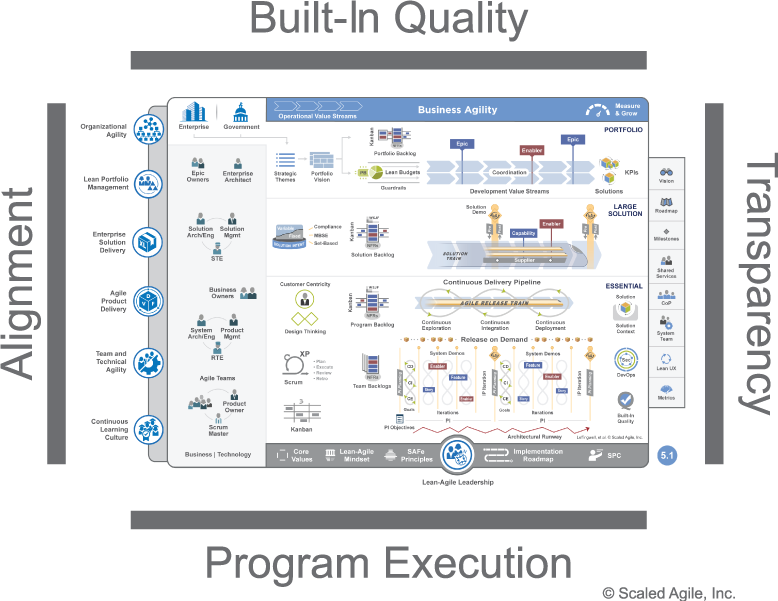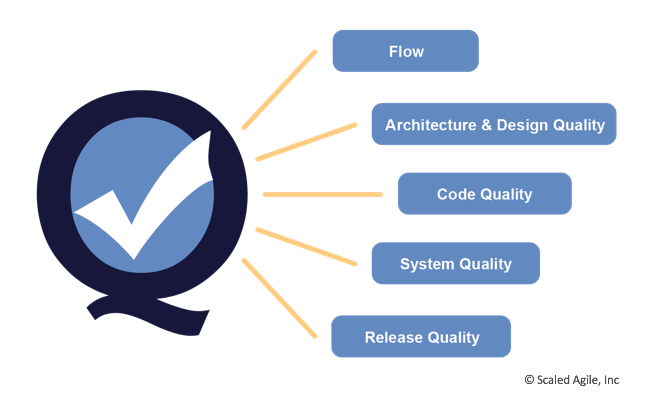Find people who share your values, and you’ll conquer the world together.
—John Ratzenberger
Core Values
The four Core Values of alignment, built-in quality, transparency, and program execution represent the fundamental beliefs that are key to SAFe’s effectiveness. These guiding principles help dictate behavior and action for everyone who participates in a SAFe portfolio.Details
SAFe is based on four primary bodies of knowledge: Agile development, Lean product development, systems thinking, and DevOps. That makes SAFe broad, deep and scalable. But at its core, SAFe places the highest value on four things: alignment, built-in quality, transparency, and program execution. These are illustrated in Figure 1 and described in the following sections.

Alignment
Like cars out of alignment, misaligned companies can develop serious problems. They are hard to steer, and they don’t respond well to changes in direction [1]. Even if it’s clear where everyone thinks they’re headed, the vehicle is unlikely to get them there.
Alignment is needed to keep pace with fast change, disruptive competitive forces, and geographically distributed teams. While empowered, Agile Teams are good (even great), but the responsibility for strategy and alignment cannot rest with the combined opinions of the teams, no matter how good they are. Instead, alignment must rely on the Enterprise business objectives. Here are some of the ways how SAFe supports alignment:
- Alignment starts with the strategy and investment decisions at the Portfolio level and is reflected in Strategic Themes, Portfolio Vision, the Portfolio Backlog, and the outcomes of Participatory Budgeting. In turn, this informs the Vision, Roadmap, and the backlogs at all levels of SAFe. Continuous Exploration with Customer Centricity and Design Thinking gathers the inputs and perspectives from a diverse group of stakeholders and information sources to ensure that the items in the backlogs contain economically prioritized and refined work, ready for teams to implement. All work is visible, debated, resolved and transparent.
- Alignment is supported by clear lines of content authority, starting with the portfolio and then resting primarily with the Product and Solution Management roles, and extending to the Product Owner role.
- PI Objectives and Iteration Goals are used to communicate expectations and commitments.
- Cadence and synchronization are applied to ensure that things stay in alignment, or that they drift only within reasonable economic and time boundaries.
- Architectures and user experience guidance and governance help ensure that the Solution is technologically sound, robust, and scalable.
- Economic prioritization keeps stakeholders engaged in continuous, agreed-to, rolling-wave prioritization, based on the current context and evolving facts.
Alignment, however, does not imply or encourage top-down command and control. Alignment occurs when everyone is working toward a common direction. Indeed, Alignment enables empowerment, autonomy, and Decentralized Decision-making, allowing those who implement value to make better local decisions.
Built-in Quality
“Inspection does not improve the quality, nor guarantee quality. Inspection is too late. The quality, good or bad, is already in the product. Quality cannot be inspected into a product or service; it must be built into it.”
—W. Edwards Deming
Built-in Quality ensures that every element and every increment of the solution reflects quality standards throughout the development lifecycle. Quality is not “added later.” Building quality in is a prerequisite of Lean and flow—without it, the organization will likely operate with large batches of unverified, unvalidated work. Excessive rework and slower velocities are likely results.
Also the bigger the system, the more important endemic quality is, so there can be no ambiguity about the importance of built-in quality in large-scale systems. It is mandatory. Built-in quality is a major foundational element of SAFe, and since it’s impossible to localize the quality discussion to every specific activity or artifact that affects quality, the SAFe Built-in Quality article organizes quality thinking around five specific aspects—Flow, Architecture and Design Quality, Code Quality, System Quality and Release Quality, as Figure 2 illustrates.

The DevOps article provides deeper technical guidance for DevSecOps practices that ensure build-in quality and security are integral to how enterprises develop software-based solutions. In addition, these articles are augmented by three Advanced Topic articles, Agile Testing, Behavior-Driven Development (BDD) and Test-Driven Development. Together, this set of articles provides a fairly comprehensive starting point for achieving built-in quality in large systems.
Transparency
Solution development is hard. Things go wrong or do not work out as planned. Without openness, facts are obscure and decision-making is based on speculative assumptions and lack of data. No one can fix a secret.
To ensure openness—trust is needed. Trust exists when the business and development can confidently rely on another to act with integrity, particularly in times of difficulty. Without trust no one can build high-performance teams and programs, nor build (or rebuild) the confidence needed to make and meet reasonable commitments. And without trust, working environments are a lot less fun and motivating.
Building trust takes time. Transparency is an enabler of trust, provided through several SAFe practices:
- Executives, Lean Portfolio Management, and other stakeholders can see the Portfolio Kanban and program backlogs, and they have a clear understanding of the PI Objectives for each Agile Release Train or Solution Train.
- ARTs have visibility into the team’s backlogs, as well as other Program Backlogs.
- Teams and programs commit to short-term, visible commitments that they routinely meet.
- Inspect and Adapt occurs with all relevant stakeholders and creates backlog improvement items from lessons learned.
- Teams and Agile Release Trains (ARTs) can see portfolio business and enabler Epics. They have visibility into new initiatives.
- Progress is based on objective measures of working solutions. (Principle #5)
- Everyone can understand the velocity and WIP of the teams and programs; strategy and the ability to execute are visibly aligned.
- Programs execute reliably, as noted below.
Lean-Agile Leaders also play a critical role in creating an environment that fosters trust and transparency.
Program Execution
Of course, none of the rest of SAFe matters if teams can’t execute and continuously deliver value. Therefore, SAFe places an intense focus on working systems and business outcomes. History shows us that while many enterprises start the transformation with individual Agile teams, they often become frustrated as even those teams struggle to deliver more substantial amounts of solution value, reliably and efficiently.
That is the purpose of the ART, and that is why SAFe focuses implementation initially at Essential SAFe. In turn, the ability of Value Streams to deliver value depends on the ability of the ARTs and Solution Trains.
But with alignment, transparency, and built-in quality on the team’s side, they have a little ‘wind at their back.’ That enables a focus on execution. And if they struggle—and they will, because complex solution development is hard—they have the cornerstone of the Inspect and Adapt workshops. In that way, they close the loop and execute better and better during each Program Increment.
Leadership is Required
Successful scaled Lean-Agile development and these four core values require the active support of Lean-Agile Leadership and a Continuous Learning Culture. Leaders couple these core values with SAFe Lean-Agile Principles and practices and an orientation toward creating value for customers. In turn, that creates a persistent and meaningful culture for the teams and their stakeholders.
This is the way successful teams and programs are doing it, and that’s why they are getting the many benefits—employee engagement, productivity, quality, and time to market—that Lean-Agile enterprises so enjoy.
Learn More
[1] Labovitz, George H., and Victor Rosansky. The Power of Alignment: How Great Companies Stay Centered and Accomplish Extraordinary Things. Wiley, 1997.[2] Manifesto for Software Development. http://AgileManifesto.org [3] Oosterwal, Dantar P. The Lean Machine: How Harley-Davidson Drove Top-Line Growth and Profitability with Revolutionary Lean Product Development. Amacom, 2010.
Last update: 10 February 2021





